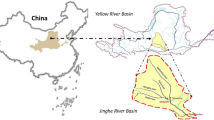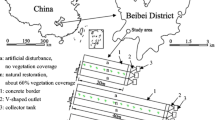Abstract
This study examines rainfall thresholds for erosion and sediment yield in the upper Yangtze River basin. Sediment reduction effects of soil conservation measures depend on the magnitudes of rainstorm. When the latter is less than a critical threshold, sediment reduction effects of soil conservation measures are positive; when this magnitude is exceeded, the effect is negative. An analysis based on data from the Jialingjiang River shows that the sediment reduction by soil conservation measures increased with annual precipitation to a peak, and then decreased to a negative value. The annual precipitation at the peak and zero values of sediment reduction are 970 and 1,180mm, respectively, which can be regarded as two thresholds. Annual precipitation at the zero-value of sediment reduction has a return period of 25years. In general, the design standard of soil conservation works in China is related with rainstorms with return periods of 10–20years. When the magnitude of rainstorm exceeds this, the soil conservation works may be partly or totally destroyed by rainstorms, and the previously trapped sediment may be released, resulting in a sharp increase in sediment yield. It was also found in the lower **shajiang River that when annual precipitation exceeds 1,050mm or high-flow season precipitation exceeds 850mm, the annual sediment yield increased sharply. These can also be regarded as key rainfall thresholds for erosion and sediment yields. When precipitation is less than the two thresholds, dominant erosion types are sheet, rill and gully erosions. When precipitation crosses the two thresholds, debris flows may occur more frequently. As a result, the previously stored loose sediment is released and sediment yield increases sharply.











Similar content being viewed by others
References
Cai ZX (1998) Building the flood-protection system in Sichaun province: the role of soil conservation. Soil Conserv Yangtze River Basin 4:20–22 (in Chinese)
Douglas I (1967) Man, vegetation and sediment yield of river. Nature 215:925–928
Experts Group on Sediment Issues of the Three Gorges Project (2002) A study of sediment issues of the three gorges project, vol 8. Press of Intellectual Property Right, Bei**g, pp 5–8 (in Chinese)
Hu SX, ** CX (1999) Theoretical analysis and experimental study on the critical slope of erosion. Acta Geogr Sin 54(4):348–356 (in Chinese)
Hydrological Bureau, the Yangtze River Water Conservancy Commission (2002) A study of sediment-reduction effect of soil conservation measures in the Jialingjiang River basin. In: Experts group on sediment issues of the three gorges project, a study of sediment issues of the three gorges project, vol 4. Press of Intellectual Property Right, Bei**g, pp 1–173 (in Chinese)
Langbein LB, Schumm SA (1958) Yield of sediment in relation to mean annual precipitation. Trans, Am Geophys Union 39:1076–1084
Meng QM (1996) Soil and water conservation on the loess plateau of China. Publishing House for Yellow River Conservancy, Zhengzhou (in Chinese)
Montgomery DR, Dietrich WE (1994) Landscape dissection and drainage area-slope thresholds. In: Kirkby MJ (ed) Process models and theoretical geomorphology. Wiley, Chichester, pp 221–245
Morgan RPC, Mengomezulu D (2003) Threshold conditions for initiation of valley-side gullies in the Middle Veld of Swaziland. Catena 50(2–4):401–414
Patton PC, Schumm SA (1975) Gully erosion, Northwestern Colorado: a threshold phenomenon. Geology 3:83–901
Prosser IP, Abernethy B (1996) Predicting the topographic limits to a gully network using a digital terrain model and process thresholds. Water Resour Res 32(7):2289–22981
Ran DC, Liu LW, Zhao LY (2000) Water and sediment changes in relation with soil conservation measures in the middle Yellow River Basin. Publishing House for Yellow River Water Conservancy, Zhengzhou, pp 1–274 (in Chinese)
Schumm SA (1977) The fluvial system. Wiley, New York, p 338
Shi LR (1998) Soil loss, its control measures and beneficial effect in the Yangtze River basin. People’s Yangtze River 29(1):41–43 (in Chinese)
Tang KL (ed) (1990) Regional characteristics of soil erosion on the loess plateau and its control. China Science and Technology Press, Bei**g, pp 1–246 (in Chinese)
Torri D, Sfalanga M, Chisci G (1987) Threshold conditions for incipient rilling. In: Bryan RB (eds) Rill erosion: processes and significance. Catena Suppl 8:97–1051
Vandaele K, Poesen J, Govers G, Wesemael B (1996) Geomorphic threshold conditions for ephemeral gully incision. Geomorphology 16:161–173
Vandekerckhove L, Poesen J, Oostwoud Wijdenes D, de Figueiredo T (1998) Topographical thresholds for ephemeral gully initiation in intensively cultivated areas of the Mediterranean. Catena 33:271–292
Walling DE, Webb BW (1983) Patterns and sediment yield. In: Gregory KJ (ed) Background to palaeohydrology. Wiley, Chichester, pp 69–100
Wang G, Fan Z (eds) (2003a) A study of water and sediment changes in the Yellow River, vol 1. Publishing House of Yellow River Water Conservancy, Zhengzhou (in Chinese)
Wang G, Fan Z (eds) (2003b) A study of water and sediment changes in the Yellow River, vol 2. Publishing House of Yellow River Water Conservancy, Zhengzhou (in Chinese)
Xu JX (2000) Water and sediment changes in relation with forest destruction in the upper reaches of the Yangtze River. J Hydraul Eng 1:72–80 (in Chinese)
Xu JH, Niu YG (2000) Effect of hydraulic engineering works on river flow and sediment load in the middle Yellow River Basin. Publishing House for Yellow River Water Conservancy, Zhengzhou, pp 1–296 (in Chinese)
Xu JX (1994) Zonal distribution of river basin erosion and sediment yield in China. Chin Sci Bull 39(16):1356–1361
Xu JX (2005) Precipitation-vegetation coupling and its influence on erosion on the Loess Plateau, China. Catena 64:103–116 (in Chinese)
Yangtze River Water Conservancy Commission (1992) Soil and water conservation in the upper Yangtze River Bansin. China education Books Export and Import Company, Shenzhen (in Chinese)
Zhang XB, Wen AB (2002) Variation of sediment in upper stream of Yangtze River and its tributaries. J Hydraul Eng 4:56–59 (in Chinese)
Acknowledgments
The financial support from the National Major Basic Research Program of China (grant number 2003CB415202) and the National Natural Science Foundation of China (40671019) is gratefully acknowledged. All hydrometrical data used in this study come from the Yangtze River Basin Water Conservancy Commission. I wish to express my deep gratitude Professor J. Philips and another anonymous reviewer, for valuable suggestions and comments.
Author information
Authors and Affiliations
Corresponding author
Rights and permissions
About this article
Cite this article
Xu, J. Some rainfall-related thresholds for erosion and sediment yield in the upper Yangtze River basin. Environ Geol 56, 1183–1192 (2009). https://doi.org/10.1007/s00254-008-1218-z
Received:
Accepted:
Published:
Issue Date:
DOI: https://doi.org/10.1007/s00254-008-1218-z




